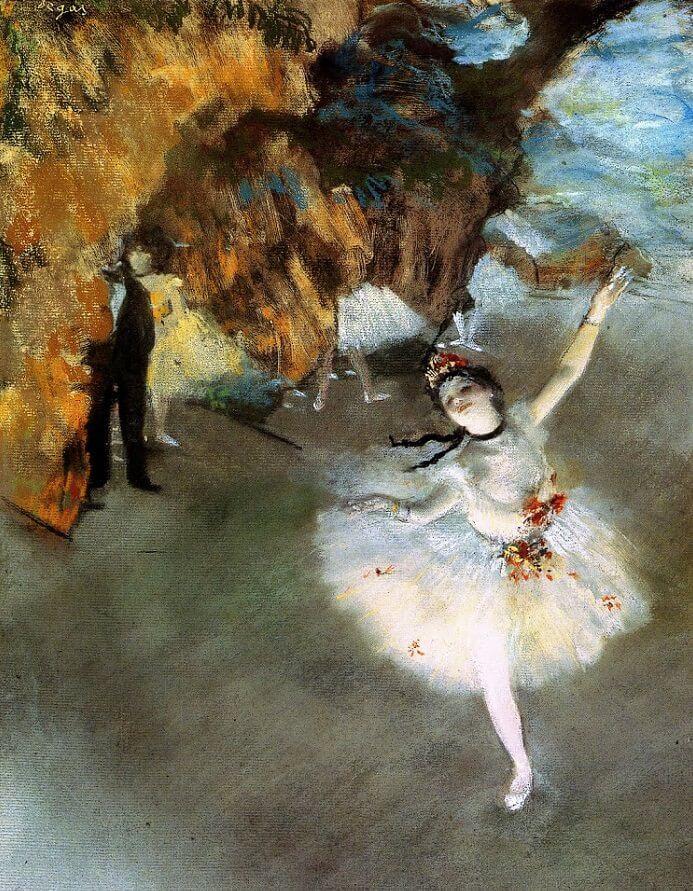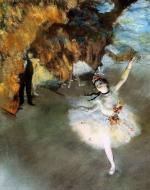Created by Liliona Blunt on Wed, 11/10/2021 - 21:41
Description:
Painted by Edgar Degas in the 19th century, this artwork depicts a single ballerina dancing upon the stage of the Paris Opera Ballet House while hidden figures look on behind the stage curtains.
Inspired by the darker happenings of the Paris Opera Ballet, Degas hoped to convey not only the beauty and grace of ballet, but the control held over these dancers by the company’s patrons. The depicted girl arches her body in triumphant accomplishment and mastery, but sadly her achievement could not be credited only to skill. Hidden behind the curtain are other ballerinas awaiting their debut, but among them is a dark figure depicted in a painting style drastically different from all else surrounding him, perhaps emphasizing his “out of place” existence or that he does not belong in such an area. This man represents the "patron men" Degas himself witnessed at the Paris Opera Ballet House. With their presence in mind, the Paris Opera Ballet House was constructed with extra space behind the stage that would serve as private access to the performers. The men who took advantage of the space were those who heavily donated to the program and at many times paid for a dancer's way of life in return for sexual favors. Often coming from low class, these aspiring young women were not paid enough during the 19th century to fully support themselves or afford their necessary dancing gear, many times forcing them to accept the advances of strangers. If they were to deny or upset these men, the patrons could force the company to fire them. If these women accepted the advances, not only would they receive a livable income, but also have a better chance at success through the patron's promotion or offerings of private lessons. The black man behind the curtain is possibly this depicted single dancer’s patron, or reason for her success. Unfortunately, due to social stigma, even if she had not accepted a patron she would still have been assumed a prostitute by others. Degas’ work drew attention to the privilege of the wealthy in France and exploitation of the poor. Other works he revealed to the public, such as the “Little Dancer Aged Fourteen,” were received with disgust. The disgust was due to the “realism” of the work, as it depicted a young girl studying at the Paris Opera Ballet who was part of a group known as the petits rats de l’operaI, or opera rats. Young students of ballet were named Opera Rats for their “scuttling” about the stage in quick steps, with the intentional insult to their background of poverty. With her arms uncomfortably stretched behind her back with her best attempts at keeping her head held high, the sculpture reflects the sexually exploitative position young girls were forced into to financially support themselves, their family, and further their career as a dancer.
Blakemore, Erin. “Sexual Exploitation Was the Norm for 19th Century Ballerinas.” History.com, A&E Television Networks, 5 Jan. 2018, https://www.history.com/news/sexual-exploitation-was-the-norm-for-19th-century-ballerinas.
“Most Popular Paintings.” The Star, 1878 by Edgar Degas, https://www.edgar-degas.net/the-star.jsp.
“Little Dancer Aged Fourteen.” Art Object Page, https://www.nga.gov/collection/art-object-page.110292.html.
Copyright:
Associated Place(s)
Timeline of Events Associated with L'étoile by Edgar Degas
Part of Group:
Featured in Exhibit:
Artist:
- Edgar Degas


